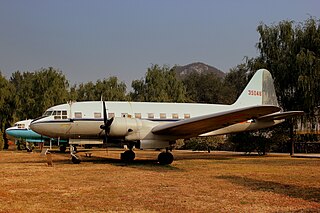
The Antonov An-10 Ukraina is a four-engined turboprop passenger transport aircraft designed in the Soviet Union.

The Ilyushin Il-12 is a Soviet twin-engine cargo aircraft, developed in the mid-1940s for small and medium-haul airline routes and as a military transport.
Aviaarktika was a Soviet airline which started operations on 1 September 1930 and was absorbed by Aeroflot on 3 January 1960.

The 22 January 1971 Surgut Aeroflot Antonov An-12 crash occurred when an Aeroflot Antonov An-12B, registered CCCP-11000, flying from Omsk Tsentralny Airport, in the Soviet Union's (RSFSR) on 22 January 1971, crashed 15 km (9.3 mi) short of the runway on approach to Surgut International Airport, Surgut, RSFSR. An investigation found the aircraft's ice protection system was ineffective because the engine bleed air valves were closed during the flight; ice therefore built up on the aircraft causing it to go out of control.

Palair Macedonian Airlines Flight 301 was a scheduled international passenger flight from Skopje to Zurich, operated by Palair Macedonian, the then-flag carrier of Macedonia, now called North Macedonia. On 5 March 1993, the aircraft operating the flight, a Fokker 100, crashed shortly after taking off from Skopje Airport in snowy conditions. Out of the 97 passengers and crew members on board, only 14 survived. At the time, it was the deadliest air disaster in North Macedonia.

Aeroflot Flight 191 was a Soviet domestic passenger flight from Vnukovo International Airport to Ashkhabad International Airport, with a stopover in Krasnovodsk Airport. On 5 March 1963, the Ilyushin Il-18 crashed while landing at Ashgabat International Airport as a result of a dust storm. 12 of the 54 people on board were killed.

The Antonov An-12 is a transport aircraft designed and manufactured by the Ukrainian manufacturing and services company Antonov. Given the long operational history of the An-12, more than 190 An-12s have crashed involving many casualties. The An-12 has also been involved in a number of aviation incidents.

Aeroflot Flight 513 was a domestic scheduled passenger flight operated by Aeroflot that crashed during takeoff from Kuybyshev Airport in the Soviet Union on 8 March 1965, resulting in the deaths of 30 passengers and crew. It was the first fatal accident involving a Tupolev Tu-124.

Aeroflot Flight 1080 was a Soviet domestic passenger flight from Sverdlovsk, Russia, to Dzhambul, Kazakhstan, that crashed at night shortly after takeoff on 7 October 1978. All 38 passengers and crew were killed in the crash which occurred when one of the engines failed due to icing during initial climb out. At the time, the crash was the second worst in the history of the Yakovlev Yak-40, which had entered operational service with Aeroflot just ten years prior.

Aeroflot Flight 5003 was a Soviet domestic cargo flight that crashed during climb out on 14 January 1967. The Antonov An-12B was flying between Novosibirsk and Krasnoyarsk in Russia with a crew of six when it crashed. It was carrying industrial parts from Moscow to Khabarovsk with several intermediate stops in between, however it caught fire shortly after takeoff, resulting in a fatal accident. At the time Flight 5003 was being operated by Polar Aviation Management under Aeroflot.

Aeroflot Flight 213 was a regularly scheduled passenger flight operated by Aeroflot from Chersky Airport to Keperveyem Airport. On 18 September 1962, the Ilyushin Il-14 operating this flight crashed shortly after takeoff. All 27 passengers and five crew members were killed.

Ryan International Airlines Flight 590 was a cargo flight carrying mail for the United States Postal Service from Greater Buffalo International Airport (BUF) in Buffalo, New York, to Indianapolis International Airport (IND) in Indiana, with a stopover at Cleveland Hopkins International Airport (CLE) in Cleveland, Ohio. On February 17, 1991, the McDonnell Douglas DC-9-15RC operating the flight crashed on takeoff from Cleveland during icing conditions. Both pilots, the aircraft's only occupants, were killed. The National Transportation Safety Board (NTSB) determined that the causes of the crash were the flight crew failing to deice their aircraft, and the inexperience of the Federal Aviation Administration (FAA), McDonnell Douglas, and Ryan International Airlines with icing condition on DC-9-10 aircraft.

Aeroflot Flight 10 was a scheduled passenger flight from Yuzhno-Sakhalinsk Airport to Vnukovo Airport with stopovers at Krasnoyarsk Airport and Severny Airport. On 27 September 1954, the Ilyushin Il-12 operating the route crashed near Severny Airport after it struck trees.

The Aeroflot Flight H-75 was an aviation accident involving an Antonov An-24B aircraft operated by the Kiev United Aviation Squadron (Aeroflot), which occurred on Sunday, January 6, 1974, near Mukachevo, resulting in the deaths of all 24 people on board.

Aeroflot Flight 17 was an aviation accident involving an Ilyushin Il-12 aircraft operated by Aeroflot on May 13, 1949 near Novosibirsk. The crash resulted in the deaths of all 25 people on board.

Aeroflot Flight 136 was an aviation disaster involving an Ilyushin Il-12P passenger aircraft operated by Aeroflot, which occurred on Thursday 28 October 1954 in Krasnoyarsk Krai, on the slope of Mount Sivukha. The crash resulted in the deaths of 19 people.

Aeroflot Flight 105 was an aviation accident involving an Ilyushin Il-12P aircraft operated by Aeroflot, which occurred on June 9, 1958 near Magadan, resulting in the deaths of 24 people.

The 1958 Lazo Il-12 crash was an aviation accident involving an Il-12P aircraft operated by Aeroflot, which occurred on Friday, 19 September 1958 in the Lazo District, resulting in the deaths of all 28 people on board.

Aeroflot Flight 783 was an aviation accident involving an Ilyushin Il-12P aircraft operated by Aeroflot, which occurred on Tuesday, October 27, 1953, near Magadan, resulting in the deaths of 22 people.
3. Notable victims of the tragedy (passengers): Sheenson M.S., Borisov V. (patronymic not established), Gulyaeva (name and patronymic not established). The remains of all three were buried in a common grave at the Danilovsky Cemetery in Moscow.













